What Charles Bafford has displayed on a picnic table in front of his home at Main and Terminal is no longer a shocking sight in the Ā鶹“«Ć½Ó³»of 2019: containers and bags full of needles.
He estimates there are about 1,500.
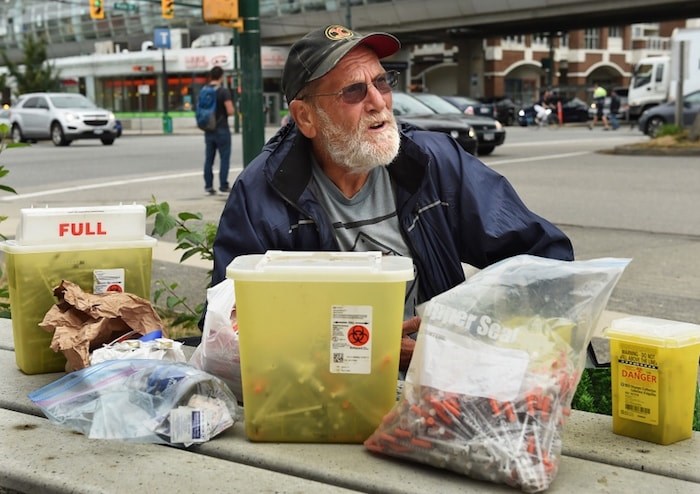 Charles Bafford, who lives in a modular housing building at Main and Terminal, spends his days picking up discarded needles in Vancouver. Photo by Dan Toulgoet/Ā鶹“«Ć½Ó³»Courier
Charles Bafford, who lives in a modular housing building at Main and Terminal, spends his days picking up discarded needles in Vancouver. Photo by Dan Toulgoet/Ā鶹“«Ć½Ó³»Courier
Some are used, some are still in the package.
Whatās significant and impressive about the haul is the 64-year-old Bafford voluntarily picked up every one of the discarded syringes by himself.
He found them in the streets, on sidewalks, on benches, in stairwells, in alleys, in parks, in playgrounds, in bushes, in planter boxes, under bridges and on the small island near Olympic Village.
It took him a few months.
Going back about a year, when Bafford began his morning routine of picking up garbage in and around his neighbourhood, he estimates his total needle haul at close to 4,000.
Over the same period, heās collected and dumped piles and piles of garbage, filling up his five gallon bucket several times during his rounds.
He does this most days.
Early on, he would dispose of the syringes in sharps containers at his modular housing building and at a needle exchange near Main and Hastings.
Now he holds on to them and takes his collection ā stuffed in gym and shopping bags ā around town and creates the occasional guerilla-like art/education project.
He did one a couple weeks ago.
Bafford took a handful of needles and other drug paraphernalia and spelled out āthe earth cries ocean roars our kids dieā on the plaza at the Olympic Village. He has a photo of it on his phone.
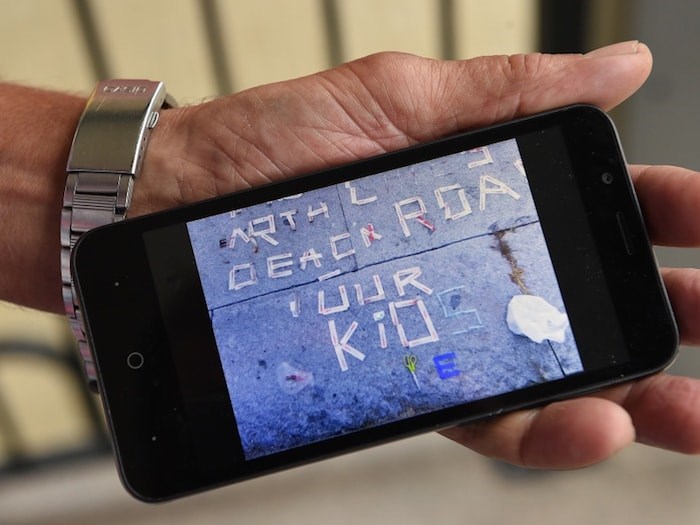 Charles Bafford shows his art/education display at the Olympic Village. Photo by Dan Toulgoet/Ā鶹“«Ć½Ó³»Courier
Charles Bafford shows his art/education display at the Olympic Village. Photo by Dan Toulgoet/Ā鶹“«Ć½Ó³»Courier
Two realtors who were about to show a condo at the Village called the cops on him because they didnāt like what they saw. Parks staff showed up but eventually let him be.
āIām showing people the reality of the situation,ā he said from the °ä“Ē³Ü°ł¾±±š°łās office the day before a reporter and photographer joined him on his route. āI donāt mean to scare people, just to let them know to be careful, to be aware so they donāt get hurt.ā
Gambling addiction
What drives Bafford to do what he does takes some more explaining.
On the surface, itās about keeping the elderly and kids ā mostly the kids ā from poking themselves with a discarded syringe. He also likes a clean city.
āItās just unnecessary,ā he said of the garbage and needles littering the streets.
The deeper motivation for Bafford, who lives on social assistance, is to make amends of a life torn apart from his addiction to gambling.
Betting on horse races provided the rush.
His addiction led to divorces, the loss of a house, cars and a steady job in building restoration. He hasnāt seen his two sons and daughter in more than 30 years.
āI was all or nothing, and I never got all,ā said Bafford, who is originally from Baltimore, Maryland, which horse racing fans would know as the home of the Preakness Stakes.
Bafford moved to London, Ont. in 1979 after meeting and marrying a Canadian nurse. He described her as an angel.
āI left her because of me,ā he said of his eight-year marriage.
After going through another divorce, and still in the grips of his addiction, Bafford went from shelter to shelter in Ontario until working his way west to Vancouver.
That was in 2006.
When he arrived, he stayed in more shelters and transitioned to single-room-occupancy hotels, including the Regal and the Clifton.
At some point, he ended up under the Granville Street Bridge before seeking shelter at the Union Gospel Mission. From there, he sought treatment at a rehabilitation centre in Kelowna for drug users and alcoholics.
He said heās never been an injection drug user, but smoked crack cocaine for a short period to keep from descending into total despair.
āThat was my medication,ā he said.
The facility in Kelowna didnāt have a counsellor to treat problem gamblers. That didnāt necessarily concern Bafford, who stayed there for 18 months.
āItās all the same. If it takes everything you have, itās the same.ā
Bafford lives with depression but feels his condition is subsiding, particularly when heās out doing what he does. Aside from the odd card game, he hasnāt gambled heavily in two years.
He reads the bible regularly, which he started doing while in Kelowna. Now he has a verse that pops up on his smart phone every day.
Like this one:
āThereās nothing from without a man, that entering into him can defile him: but the things which come out of him, those are they that defile the man.ā
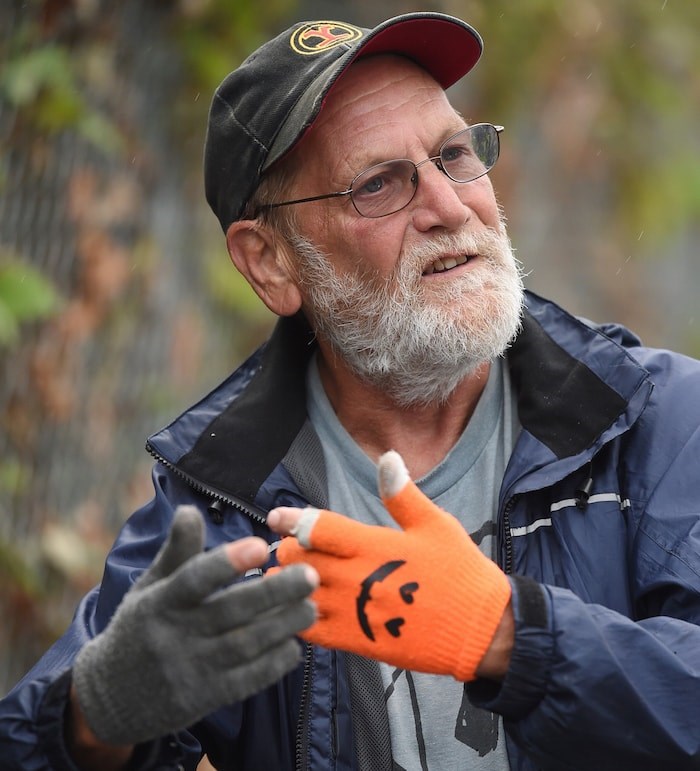 Charles Bafford during his rounds. Photo by Dan Toulgoet/Ā鶹“«Ć½Ó³»Courier
Charles Bafford during his rounds. Photo by Dan Toulgoet/Ā鶹“«Ć½Ó³»Courier
Needle poke
That verse was on Baffordās phone as he walked part of his route on a recent overcast Thursday morning. The Courier met him outside his building a few minutes before 6 a.m.
He made it clear that his purpose was for readers to get a sense of where he goes and what he finds, but cautioned it would be a quicker and less meticulous trip than he normally does.
He wouldnāt be going to Crab Park or out to the Cambie Bridge, as he normally does.
āI can easily spend an hour just in Thornton Park,ā he said, noting he walks the park near Main and Terminal in an up-and-down grid like a farm tractor tilling the earth.
Dressed in a T-shirt, jeans, casual shoes, a navy windbreaker and a black ball cap, the grey-bearded Bafford could be mistaken for a retired commercial fisherman.
He had a small empty Maxwell House coffee jar with him and a pair of gloves ā one was grey, the other was orange with a happy face on it.
The jar is for needles.
Fifteen minutes later, he was filling it with needle after needle behind a short retaining wall at Trillium Park on National Avenue. He dropped eight in the container.
āThis is the fresh stuff,ā he said. āUnderneath the dead leaves [theyāre resting on], thereās going to be more of them. But I donāt go rooting.ā
In the distance, four tents were pitched near a playground. Across the turf soccer field from Bafford, a park board worker was making his rounds, carrying a picker and a bucket.
The worker didnāt want to give his name, but was happy to talk and show the prick mark on his thumb from a needle. It happened a couple of days ago in Thornton Park.
He didnāt see the needle concealed in the sweater he picked up. He checked in to St. Paulās Hospital and got a tetanus shot. That visit will be followed by several more over the next year to ensure he is disease-free.
He also shared that he heard recently from a dog owner at Strathcona Park that a dog got stuck with a needle and had to have it surgically removed.
āItās just the way people are,ā he said.
He knows Bafford and says hello when he approaches.
āI was just saying [to the Courier] itās good that you do this in the morning, voluntarily,ā he said. āThatās awesome.ā
Bafford: āIām just trying to get the needles out.ā
Worker: āBut the fact that you do this on your own is awesome. I was just telling [Courier reporter] it shows me that you care and people do care.ā
Bafford: āI know people care because citizens have come up to me and told me they pick them as well. To me, citizens shouldnāt have to do this.ā
The worker told him about getting poked with a needle at Thornton Park, which Bafford walked through 15 minutes ago.
āThatās so wrong,ā Bafford said.
āHere I am working,ā the worker replied. āCan you imagine kids and people?ā
He paused, shrugged his shoulders.
āJust the way it is.ā
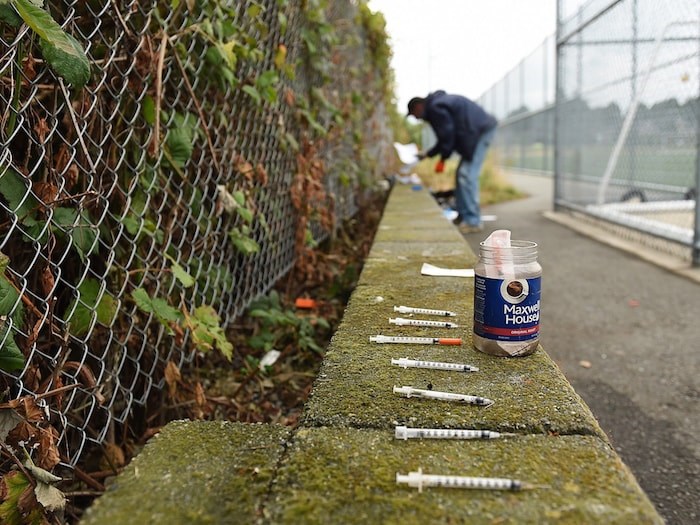 Needles found at Trillium Park. Photo by Dan Toulgoet/Ā鶹“«Ć½Ó³»Courier
Needles found at Trillium Park. Photo by Dan Toulgoet/Ā鶹“«Ć½Ó³»Courier
235,778 needles recovered
The worker carried on, as did Bafford, who was clearly frustrated by what he just heard as he walked along a path on National Avenue, heading back to the south side of Terminal.
āHeās trying to do something good and he gets stuck,ā he said, emphasizing the word āstuckā in his comment. āThereās something wrong with that.ā
What Bafford didnāt hear the worker say was how the original intention of a needle exchange was to have addicts return used syringes to the supplier, or discard them in a safe manner in a sharps container.
In other words, one clean needle goes out, one dirty one comes in.
That is visibly not the case in todayās Vancouver. Statistics from Ā鶹“«Ć½Ó³»Coastal Health for 2017 show 235,778 needles were recovered in Vancouver.
That statistic doesnāt include the many thousands collected by housing providers, pharmacies and other safe disposal sites. Or by Bafford, for that matter.
The data also doesnāt break down the number of needles, for example, picked up in an alley versus the number safely returned to a depot.
A couple of other data points: The same year ā 2017 ā the health authority recorded 235,778 needles recovered, the B.C. Centre for Disease Control reported 9,513,625 needles delivered to various agencies in Vancouver.
The math, though, isnāt as simple as subtracting 235,778 needles recovered from 9,513,625 needles delivered to determine unaccounted needles.
Not all needles delivered to agencies in a given year are used that same year, not all are for injection drug use and, as mentioned above, the health authority doesnāt have a full account of all needles recovered.
Regardless, as Bafford has shown, discarded needles in Ā鶹“«Ć½Ó³»are easy to find and a common sight in many neighbourhoods, including the alley outside the °ä“Ē³Ü°ł¾±±š°łās office in Mount Pleasant.
Bafford is of the same mindset of the park board worker about the one clean needle for one discarded needle principle.
He understands the issue of drug use in Vancouver, where there are thousands of injection drug users, is complex and currently mired in an unprecedented opioid crisis.
Still, he believes users should pick up after themselves.
āThey need to be taught to be more respectful of the community and themselves,ā he said. āI donāt think Iām being harsh in saying that.ā
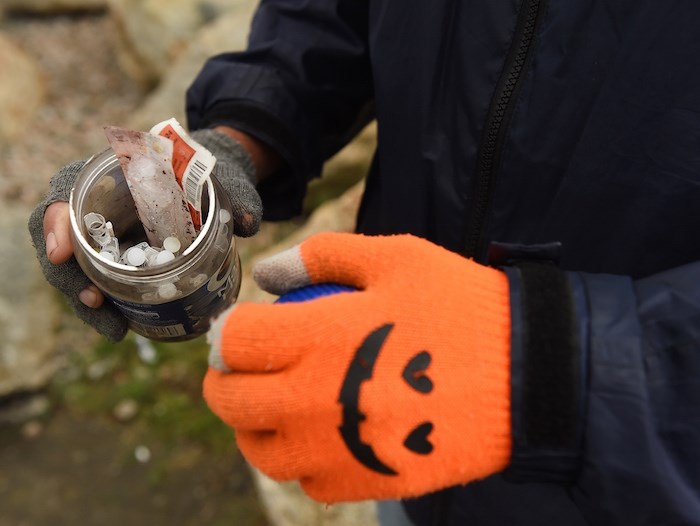 Charles Bafford uses a Maxwell House coffee jar to store the needles. Photo by Dan Toulgoet/Ā鶹“«Ć½Ó³»Courier
Charles Bafford uses a Maxwell House coffee jar to store the needles. Photo by Dan Toulgoet/Ā鶹“«Ć½Ó³»Courier
A total of 389 people died in Ā鶹“«Ć½Ó³»last year of a suspected drug overdose, the majority connected to fentanyl, the deadly synthetic opioid.
A significant death toll when compared to the 42 who died in 2010.
The B.C. Centre for Disease Control, using data from 2015, estimated the number of injection drug users in Ā鶹“«Ć½Ó³»at 8,500 people, many of whom reside in the Downtown Eastside.
Bafford makes a point of saying he never confronts a drug user during his rounds. That was evident when he came across a young man injecting himself in a stairwell near the Main Street SkyTrain station.
At the same time, he said, the system designed to give drug users clean injection supplies has broken down somewhere when citizens like him and others are able to easily find needles.
āThe city has created this problem, and theyāre going to have to fix it,ā he said, describing a needle exchange as a stock exchange, explaining that the service has spawned its own industry of needle production and recovery.
Continuing on his route, he walks along an asphalt path behind the office buildings and car dealerships that line the south side of Terminal Avenue. He finds more needles in planters and on the ground next to a large grouping of boulders.
He stops at a pile of open black plastic garbage bags, the contents strewn over a piece of plywood balanced on a cart. Needles are visible, which indicates to Bafford that the person who initially bundled up the bags was probably a user, probably homeless.
āYou can see the hurt in the person by just looking at this,ā he said.
He then comes across a desperate scene that illustrates the angst many in the city continue to express about unaffordability in Vancouver: a person sleeping on a bench under a makeshift lean-to next to a row of new Porsches.
A total of 2,223 people in Ā鶹“«Ć½Ó³»were counted as homeless in March, but more than 1,000 didnāt participate in the survey questions about drug use.
Of the 1,156 people who did, 33 per cent said they had an addiction to opioids. Another 29 per cent had an addiction to methamphetamines, 22 per cent to alcohol, 21 per cent to marijuana and 14 per cent to cocaine.
Almost half of respondents cited a mental health issue.
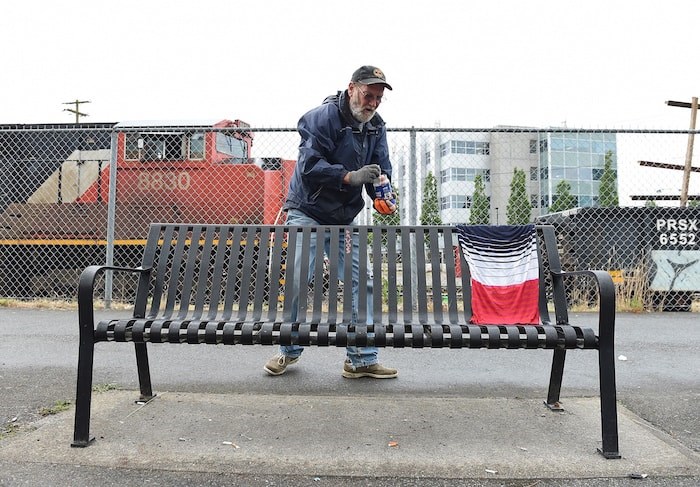 Charles Bafford picks up a discarded syringe on a path behind car dealerships on Terminal Avenue. Photo by Dan Toulgoet/Ā鶹“«Ć½Ó³»Courier
Charles Bafford picks up a discarded syringe on a path behind car dealerships on Terminal Avenue. Photo by Dan Toulgoet/Ā鶹“«Ć½Ó³»Courier
Bafford begins to head back to Main and Terminal, but not before he picks up another needle under a dumpster in an alley on Northern Street.
He crosses the intersection to walk through a breezeway dividing highrises near the Main Street SkyTrain station. Thatās where he comes across the young man putting a needle in his arm.
āIn use, in use,ā he whispers, detouring to alcoves and shrubbery where he often finds needles.
Heās been walking for about an hour-and-a-half and collected 20 needles. On average, when heās taking his time, he finds anywhere from 25 to 40.
One day, he said, he pulled more than 100 needles out of a pile of garbage bags, worried they would end up in a landfill or the ocean.
āIt really depends on the time of the month with the quantity that you get,ā he said, noting his needle haul increases the day after social assistance cheques are distributed.
By the time he reaches Science World, the city has come alive with pedestrians and cyclists. He points out hidden spots near the paddling centre where he has witnessed drug use.
Drug paraphernalia ā blue rubber tourniquets, alcohol swab packages and orange plastic needle caps ā are easily visible in some shrubs near the Olympic Village plaza.
āThis is the aftermath of someone living in there, and using in there,ā he said. āItās sad, really.ā
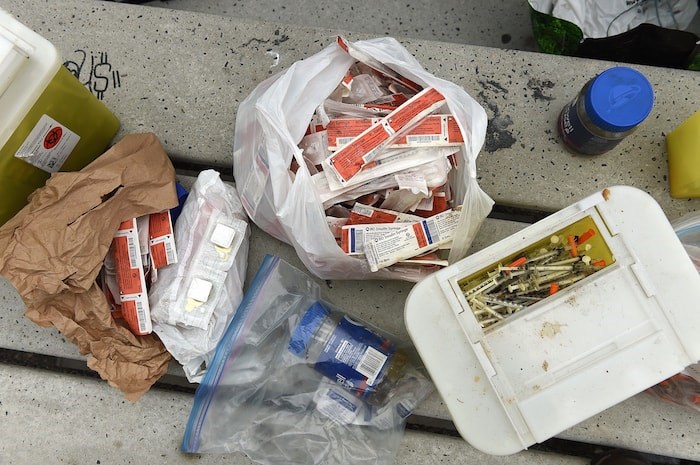 Charles Bafford estimates heās collected close to 4,000 needles since last year. Photo by Dan Toulgoet/Ā鶹“«Ć½Ó³»Courier
Charles Bafford estimates heās collected close to 4,000 needles since last year. Photo by Dan Toulgoet/Ā鶹“«Ć½Ó³»Courier
āI do what I doā
Itās close to 8 a.m. when Bafford returns home to gather up his collection of needles for the Courier to see. He places four yellow sharps containers and a couple of bags on the picnic table.
Thereās moreĀ in his room.
A friend named Keith, who lives at a nearby shelter, happens to walk by. Heās in a hurry but stops long enough to talk about Bafford, whom he met six months ago.
āHeās great,ā he said. āHe picks up the garbage and no one else does. He does this all day long.ā
Bafford reiterates that heās not the only person who picks up needles. He doesnāt want recognition for what he does, but recognition of the problem of needles littering the streets.
That will be emphasized in his plans for another impromptu art/education project with his needles outside the Main Street SkyTrain station, and another in front of the cruise ship terminal at Canada Place.
In the meantime, he said, he will continue to scour the city for needles and garbage, referring to a classic Spanish novel written in the 1600s by Miguel de Cervantes to make some sense of what drives him.
āI do what I do. Thatās my windmill ā whether Iām the ass, or Don Quixote, Iām one of them. And thatās OK because I think Iām doing something good, and thatās the bottom line. Thatās my very, very bottom line ā Iām doing something good.ā
Needle use in the city:
Ā鶹“«Ć½Ó³»Coastal Health provided the Courier with statistics and emailed comments related to needle use in the city, including this one from public affairs leader Carrie Stefanson:
āWhile the majority of needles used by people who use substances are appropriately discarded, we understand the frustration of community members when they come across discarded needles.ā
Some more statistics and facts:
- The health authority funds 32 community sweeps per week, which amounts to approximately 1,700 per year. A mobile needle exchange operated out of a van runs 20 hours per day.
- The health authority operates more than 40 outdoor needle disposal boxes across the city in partnership with the City of Ā鶹“«Ć½Ó³»and PHS Community Services. They are located in alleys and parks.
- Needles are also collected at eight community health centres and at many community-based locations in Vancouver.
- More needles are recovered from May to September when the weather is warmer and people who use drugs are outside.
- No one has ever acquired HIV, or any other pathogen, from a needle-stick injury from a discarded needle in a park or any other public place in Vancouver.
- Community needle sweep crews focus their efforts on āhot spotsā wherever they are identified. Areas where children play is a priority.
- Citizens who find discarded syringes can call theĀ needle recovery hotline at 604-657-6561. The service can also be accessed byĀ calling the cityās 3-1-1 call centre.


